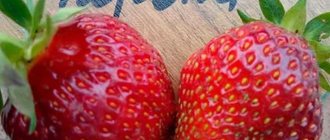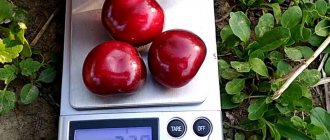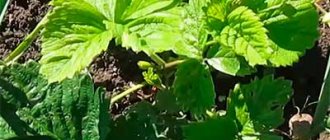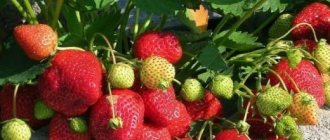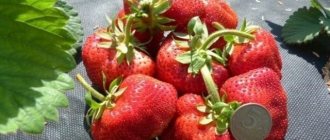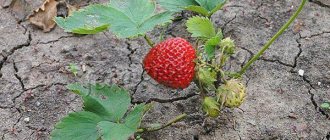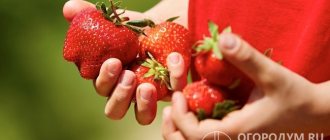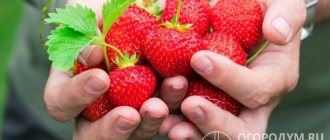Description and characteristics of the Fleur variety
The variety is considered early ripening, as it is 7-10 days ahead of other early varieties. Active fruiting is characterized by a short period. Full ripening of the berries occurs within a month.
The berries have a classic shape in the form of an elongated cone. Tall peduncles form on the bushes, and an average number of leaves appear on the shoots. The berries are easy to pick as they are always visible.
The weight of one berry reaches 30 g, these are the largest specimens. The flesh is tender and dense at the same time. Has good taste.
Main characteristics
The variety is non-repairable, the harvest is one, but long-lasting. Fruiting, starting in June, gradually decreasing, lasts until autumn. Table 1 shows the main characteristics of Festivalnaya garden strawberries.
Review of the “Festivalnaya” garden strawberry variety in the video below:
Table 1
| Characteristics | Meaning/Description |
| Ripening time | mid-season variety (first fruits - mid-late June, peak harvest - July) |
| Fruiting | one, long |
| Productivity | 1 kg per bush |
| Berry weight | the largest berries are in the first harvest (their weight is 35-45 g), and then the fruits are smaller to 10-25 g |
| Life cycle | 3-4 years |
| Resistance to diseases and pests | medium (resistant to white spot and gray rot, but often affected by strawberry mite) |
| Drought resistance | low |
| Frost resistance | up to minus 25 °C |
| Taste | sweet and sour |
| Tasting assessment | 4.4-4.5 (out of 5 points) |
| Purpose | universal |
| Transportability | high |
| Safety | high |
Varietal pros and cons of strawberries
Advantages of culture:
- characteristic strawberry taste and aroma;
- earlier onset of flowering;
- short period of berry ripening;
- dense pulp guarantees transportation over long distances and is stored for a long time;
- a large number of long and strong peduncles appear on an open bush.
Fleur is not liked only if the gardener does not follow the growing steps. A negative result also shows poor planting material. The disadvantages include:
- In late spring conditions, the growing season begins early. As a result, strawberries have low productivity.
- Fleur does not tolerate heat well. At the peak of high temperatures, the leaves droop. If poor watering and lack of partial shade are added to this, the results are very bad.
- Gardeners growing strawberries in the Moscow region and central Russia note the lack of versatility in taste.
In the latter case, they speak of unsuccessful adaptation to climate. Also, the taste depends on agricultural technology, which was not carried out according to the rules.
History of selection and regions of cultivation of Fleur strawberries
Dutch breeders have given the world many unique hybrid varieties of berry crops, characterized by stable characteristics and excellent taste. The Fleur berry variety was developed in 2004. The new hybrid form of strawberries is resistant to humid climates and does not tolerate heat and drought at all.
Zones with moderate climatic conditions are most suitable for growing berry crops. Strawberry Fleur grows well and bears fruit both in open ground and in specially equipped greenhouses, greenhouses or tunnels.
Features of growing garden strawberries
For successful growth, Fleur requires a certain suitable growing area. The development of the crop and the quality of the harvest are influenced by the choice of location. Incorrectly carried out agricultural technology not only leads to a poor harvest, but also affects the appearance of the variety.
See also
Description and characteristics of the strawberry variety Cinderella, planting and careRead
Landing dates and location selection
The type of planting material influences the choice of site for growing strawberries. Seedlings are planted in May. Soil with any composition is suitable for Fleur. If it is light soil with normal acidity, the harvest will be large.
Fleur loves open space with direct sunlight. Winter cultivation in greenhouses also produces high yields. The place for strawberries should be away from drafts, in the sun and well lit throughout the day.
Preparation of planting material
Healthy bushes that are free from damage and have a good appearance are selected for planting. Despite this, before planting, seedlings are treated with special compounds. This will help avoid the development of diseases.
Moreover, not only the root system, but also the green part of the plant is treated.
Landing rules
For Fleur, both one-line and two-line planting schemes are suitable. This is due to the fact that the bushes are small. Leave 20 to 30 cm of free space between the sprouts. There is up to 40 cm of free space between the rows.
Features of planting strawberries
Strawberries of the Fleur variety are demanding on growing conditions and soil composition. In order to avoid mistakes and get a bountiful harvest of berries, it is necessary to take into account some features of growing berry crops.
Selection and preparation of beds
Planting work begins with choosing a place to place the berry beds:
- Well-lit areas that are not blown by the north wind or drafts are suitable for planting bushes.
- The berry crop prefers fertile soil with neutral moisture and acidity.
- Groundwater is allowed at a level of at least 1.5-2 meters from the ground surface.
- Heavy, clayey soil is diluted with a mixture of sand and humus, and peat, compost and a little clay are added to the sandy soil.
- The area is dug up, cleared of weeds and ridges are created.
In the prepared beds, make a trench or dig small holes, leaving a distance of 25 to 30 centimeters between plantings.
Choosing seedlings
The health, fruiting and productivity of the fruit crop depend on the choice of planting material.
The seedlings are inspected for damage and disease. The root system of the bushes should be well developed, without any signs of rot, nodules or tubercles.
Before planting in the ground, strawberry rhizomes are treated with professional antibacterial drugs and a growth stimulator.
Timing and technology of planting bushes
Strawberry Fleur is a perennial variety of berry crop. It is recommended to plant bushes in the soil in the spring. In this case, the first harvest of berries is harvested after a year.
In regions with warm winters, strawberries can be transferred to open ground in the fall, then you can taste the first berries in the spring.
Once the time for planting seedlings has been determined, you can begin planting activities:
- Berry bushes are installed in pre-prepared holes or trenches.
- The roots are carefully distributed and covered with fertile soil mixture.
- The soil under the bushes is lightly compacted and watered with warm water.
- The beds are mulched with a layer of dry grass.
See also
Characteristics and description of Roxana strawberries, planting and care
Read
Important! The first days after planting, seedlings are watered daily.
Tips for caring for strawberries
Fleur needs watering and fertilizing, since the growth and development of the crop depends on this. Fertilization and frequent watering speed up the growth rate. Particular attention is paid to loosening and mulching strawberry beds. It would be a good idea to cover the variety for the winter.
Watering and fertilizing
Strawberry plantings are saturated with moisture as the soil dries out. Fleur is watered with warm, settled water. To do this, the containers are filled in the morning, and throughout the day the water is heated under the sun's rays.
Water is poured at the root, making sure that drops of moisture do not fall on the shoots, flowers, berries and leaves. During the rainy season, watering is suspended, as precipitation saturates the soil well. Simultaneously with watering, strawberries are fertilized.
For Fleur, complex fertilizers containing potassium, phosphorus, nitrogen and other useful substances are suitable. Specialized drugs are purchased in stores. The powder is diluted with water, after which the plants are watered with the liquid.
Mulching and loosening
After watering, a crust forms on the surface of the earth. It does not allow the soil to breathe, so air masses do not penetrate to the root system. If the soil has dried out after watering, the beds are loosened, repeating the procedure each time.
See also
Why some strawberry bushes don’t bear fruit or even bloom and what to doRead
The event makes the soil lighter and airier. As a result, strawberries grow faster. In addition, fertilizers reach the roots faster.
A layer of mulch prevents the appearance of weeds. A special layer on the soil surface prevents the growth of weeds. Thanks to this, strawberry care is reduced. Mulching has the ability to retain moisture. The liquid does not evaporate as quickly, and regularity in watering disappears.
Preparing for winter
Strawberry bushes tolerate the cold season under cover or in tunnels. If Fleur is grown in beds, mulch of vegetable origin is used. It should not be moisture-intensive. Therefore, options such as spruce branches and corn disappear immediately.
Agrofibre is well suited for this purpose. Despite the thinness of the material, all conditions are created for successful wintering. Agrofibre allows the crop to breathe. Remaining in the garden bed until spring, protects against insect pests from penetrating the green mass.
The agrofibre is removed when the weather gets warm outside. In case of late frosts, strawberries are covered with the same agrofibre.
Description
“Alpha” strawberries are not a remontant variety; they are capable of bearing fruit only once during the season. The shape of the berries can be seen in the photo. Most often grown in open ground conditions. Planting in a greenhouse is not justified because the plant does not recoup the costs.
Strawberry bushes of the “alpha” variety are large and spreading. The long petioles bear powerful emerald green leaves with jagged edges. Since the bushes are large, a sufficient interval is required between plantings.
During the season of active growth, the crop throws out tendrils intended for vegetative propagation. Most often there are few of them, but they are massive and have a green-pink tint. The first sockets located on them are large. They grow quickly and take root easily, especially after pinning.
The variety is classified as late-ripening; flowering occurs no earlier than mid-July. From 5 to 11 inflorescences are formed on one bush; most likely, each will have an ovary. When growing, keep in mind that this variety is self-pollinating; to increase the yield, it is necessary to plant pollinating plants. Flowers are bisexual.
The berries of the crop are large, have a regular spherical shape, without a neck. The outer skin, after complete ripening, has a bright red color and pronounced shine. The pulp of ripe fruits is juicy, dense, aromatic, but quite sour. The first fruits are heavy, reaching 40 g, later they become smaller to 20-25 g.
When conditions favorable for the variety are created, the yield is high. Gardeners say that approximately 1-1.2 kg of berries can be harvested from one bush.
Disease and pest control measures
Microorganisms and insects cause a wide variety of diseases. Not only does the appearance of the plants deteriorate, but the taste of the berries and their size also suffer. The most unpleasant thing is that the variety may disappear under the influence of pest attacks.
To combat diseases, folk methods are suitable, as well as products purchased in specialized stores. In the first case, use is possible in any growing season. Preparations of chemical origin are not used at the time of berry formation and ripening.
Description of Victoria strawberries
Victoria was originally developed by crossing garden and wild strawberries. It was brought to Russia in the 18th century. Since the middle of the 19th century, it has gained popularity not only among representatives of the aristocracy, but also among other segments of the population. Since then, gardeners and gardeners everywhere have been growing large-fruited garden strawberries of various varieties, naming them in honor of Victoria, which was once bred. Considering all the available facts, it is worth considering the characteristics and tips for growing large-fruited strawberries. Currently, the Victoria variety in its original form can only be found in the collections of some breeders.
Strawberries are very thermophilic and prefer sunny places. Therefore, in the northern regions of Russia it is grown in greenhouses or at home. Otherwise the culture is unpretentious. Strawberries bear fruit no more than once a season. Not repairable. Strawberry bushes are tall, the leaves are elastic, powerful, rich green. The color of the berries is red. The fruits have high sugar content (9.2%). Large, aromatic berries are highly valued by gardeners.
Varieties of large-fruited strawberries are resistant to many diseases, but are often susceptible to white spot. Of the pests, only the strawberry mite poses a danger to them.
Collection and storage of garden strawberries
The picking of berries from the branches occurs every day at the moment of their ripening. The fruits are suitable for long-term storage in a cold room. They do not weather and at the same time retain their shine. The harvest is transported over long distances without losing its attractive appearance.
Ripe berries should not linger on the branches for long. The fact that they are overripe is indicated by the dark burgundy color of the strawberries. Such berries, even if they are already picked, will not last long and will completely deteriorate within 4-5 hours.
Planting and care
When growing Alpha strawberries, gardeners recommend adhering to the following rules:
- Seedlings should be planted in open ground in the spring, after the elimination of return frosts or at the end of August. In the first case, the bed will not produce fruit in the year of planting.
- The growth point (the center of the rosette) is placed above the ground level, without deepening it.
- When determining a place for a garden bed, crop rotation is observed. If you ignore this rule, you may not expect a harvest.
- The distance between the bushes should be at least 35-40 cm. One row from the other should be placed no closer than 70 cm.
- Before planting, prepare the holes in advance, add fertilizer to the soil and dig up the area.
Experienced summer residents do not recommend burying bushes in the soil. Remember that the plant is prone to root rot. The flooding of the neck is destructive; it will not be possible to save the plant.
Recommendations for care are classic. Strawberries should be watered regularly, avoiding overwatering. The best option is to arrange drip irrigation. It is better to place bushes in well-lit areas, without direct contact with the rays of the sun. Feeding is provided periodically, at least 3 times per season. For the winter, the crop is covered and the soil underneath is mulched.
